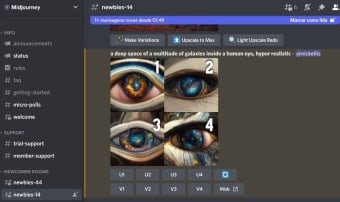Paid generative art AI
Screenshots
Midjourney is a paid AI system that generates art based on prompts. While it used to have a free trial, abuse of the tool and subsequent controversies forced the developers to use a paid-tier subscription system. It works much the same way as DALL-E and Adobe Firefly, where you insert text as a description, and then it presents images.
At the moment, it works in a Discord environment, which is where you provide a prompt. There are moderators on the system to make sure no one abuses the AI tool. Still, it hasn’t stopped the system from causing controversy by learning from the art of other artists and causing copyright issues to emerge.
Prompting an image
The basis of Midjourney is that you enter a prompt for an image, and it produces a few results. It uses machine learning to study online content related to the prompt, making a new visual. From there, you can select the ones you one for your project, or you can try again if you aren’t happy with the collection. There are also a few other commands you can try, but it’s limited.
The Discord environment
When the free trial of Midjourney was available, anyone could test the system without worrying about paying for the images. Sadly, you now have to pay for one of the tiers, which gives you a number of results based on how much you pay. Also, you need to be in the Disord environment for the prompt to work where moderators are watching what you do.
Causing controversy
Due to the nature of learning from online content made by other artists, there has been a fair amount of controversy around Midjourney. While the system is supposed to make new images, many artists have found likenesses to their original art on other platforms. It has led to court cases, so it’s best to be careful when using this tool for commercial purposes.
Creating images, with a catch
Midjourney tries its best to be an innovative AI system, but it’s simply reusing content it finds online with some changes. Despite the adjustments, content creators have found their work being copied by the tool, which leads to artistic plagiarism.
There are some uses for it, though. You can get inspiration for your own projects or use them in non-commercial ways. You’ll need to be careful where you share the results, as it may land you in trouble.

